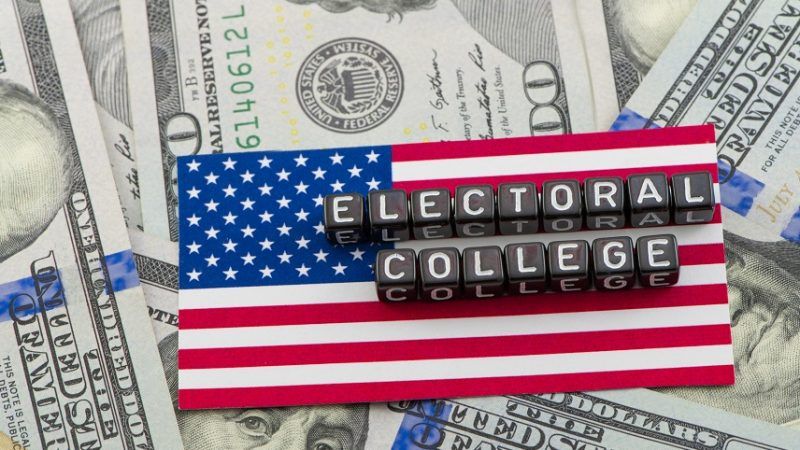No, The Electoral College Isn't Rigged to Favor Rural Trumpism
It's time to put the myth of electoral bias out of its misery.

It's time to shed the mythical claim that electoral features of the United States Constitution somehow infuse our national political system with a rural Republicanism, conservatism, or Trumpism.
This charge appears prominently in Nancy MacLean's controversial book Democracy in Chains, which cites the U.S. Senate's equal representation clause as well as the Electoral College as evidence of the Constitution's anti-democratic features. MacLean accuses libertarians of seeking to enhance these features with further constitutional "locks and bolts" that supposedly thwart the popular and progressive-leaning "will" of the electorate. But she also does little to conceal her own contempt for these existing provisions, attacking our "grossly malapportioned Senate" in which "the vote of a Wyoming resident carries nearly seventy times more weight than the vote of a Californian." Suggesting that this feature constitutes a built-in bias towards conservative voters, she describes it as even "more egregious departure" from equal voting rights than the notorious manipulations of state legislature apportionment that typified the segregation era.
Indeed, to MacLean, the claimed Senate and Electoral College biases are a pernicious anti-democratic relics of slavery's influence over the drafting of the Constitution. Today they are "change-blocking mechanisms [that] prevent us as a polity from addressing our most profound challenges," which in her mind entails imposing radical tax hikes on the wealthy to stave off "inequality" and adopting a favored package of aggressive regulatory policies to combat global warming.
Is there in fact a detectable electoral bias in a Republican direction that supposedly emerges from the Constitution itself? While the Senate and the Electoral College indeed mathematically disfavor high-population states, the specific claim that they "rig" a supposed rightward bias into our politics is far more often asserted than substantiated. A simple examination of recent electoral results reveals that there is no reason to believe that Republicans or conservatives are the exclusive beneficiaries of these constitutional features. Rather, the much-discussed Republican-leaning rural states of the west are basically canceled out by the overlooked Democrat-leaning small states of the northeast.
To see how, let's take the 10 smallest states in terms of population (2016 estimates) and tabulate how they vote. Beginning with the least-populous state and increasing in size, the list includes Wyoming, Vermont, Alaska, North Dakota, South Dakota, Delaware, Montana, Rhode Island, Maine, and New Hampshire.
This is also a mathematically defensible cutoff point, as New Hampshire's apportionment of House seats sits well below the national average of population per district. The next state on our list, Hawaii, sits slightly above. Note also that this list does not include the heavily Democrat-leaning District of Columbia, which has 3 electoral votes but no senators. The nation's capital would sit below Alaska and above Vermont in terms of population if it obtained statehood.
The current U.S. Senate representation of these ten smallest states actually shows a slight bias towards the Democrats. They currently elect nine Republicans, nine Democrats, and two independents who caucus with the Democrats. Note that this pattern is basically a wash though, even if we recognize that rural western states occasionally elect centrist Democrats such as Sen. Heidi Heitkamp of North Dakota, and small northeastern states occasionally elect centrist Republicans such as Susan Collins of Maine.
But what about the Electoral College? In the 2016 election, these same states gave 17 electoral votes to Hillary Clinton and 16 electoral votes to Donald Trump. The inclusion of D.C. would up the slight Democrat advantage to 20 electoral votes. In short, for every North Dakota (population 758,000) that tilts Republican, there's an offsetting Vermont (population 625,000) that tilts Democrat. The results for the 10 smallest states alone may be seen on this map.
The emphasis on disproportionate electoral power of rural states out west not only obscures famously left-leaning New England and its mid-Atlantic neighbors. It also distracts attention away from where the actual electoral battles tend to take place—medium-to-large population swing states like Ohio, Florida, Pennsylvania, and Michigan.
It's true that, through Electoral College quirks, these states can determine the outcome of the presidency. It's also often the case that non-competitive large population states like California, New York, and Texas may see their voting power diminished nationally, creating the circumstances in which a candidate could lose the popular vote and yet win the presidency. But note that none of these characteristics are exclusive to Republican-leaning rural states, which largely see their clout canceled out by Democrat-leaning small states.
There's little doubt that the country is currently divided between distinctive and sometimes sharply-partisan political poles. But it's time we cast off the conspiratorial talking points that suggest the Constitution electorally disadvantages a latent "progressive" popular will. These unhelpful claims of a constitutionally rigged outcome lack any basis in the realities of our current electoral math.
Show Comments (179)